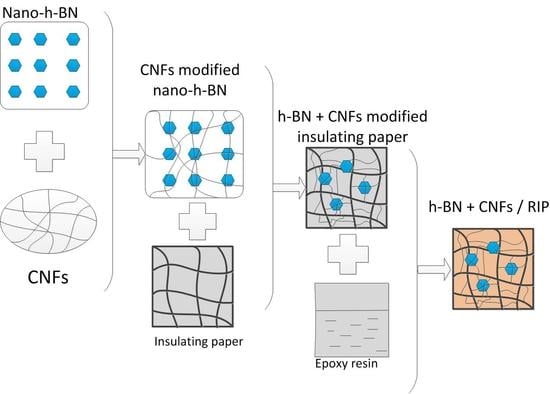Dielectric and Thermal Conductivity Characteristics of Epoxy Resin-Impregnated H-BN/CNF-Modified Insulating Paper
Abstract
1. Introduction
2. Materials and Methods
2.1. Sample Preparation
2.2. Measurement System
3. Results
3.1. SEM Test Results of the RIP
3.2. Thermal Conductivity Test Results of the RIP
3.3. DC Conductivity Test Results of The RIP
3.4. DC Breakdown Strength Test Results of The RIP
3.5. Space Charge Characteristics of the RIP
4. Discussion
5. Conclusions
- (1)
- CNF/RIP and h-BN/RIP did not increase the breakdown strength of RIP; however, they did increase the breakdown strength of 2.5–10 wt % h-BN + 0.1 wt % CNF/RIP. h-BN and CNFs were synergetic.
- (2)
- The breakdown and space charge suppression performances were the best in the case of 10 wt % h-BN + 0.1 wt % CNF/RIP. It can be a potential insulating material in the manufacturing of HVDC dry bushing.
- (3)
- In comparison with unmodified RIP, the h-BN/RIP and h-BN + 0.1 wt % CNF/RIP can suppress the space charge but CNF/RIP cannot. h-BN plays a significant role in suppressing the space charge, and CNFs can enhance its role.
Author Contributions
Funding
Conflicts of Interest
References
- Hongda, Y.; Chen, Q.; Wang, X.; Chi, M.-H.; Liu, H.; Ning, X. Dielectric and Thermal Conductivity of Epoxy Resin Impregnated Nano-h-BN Modified Insulating Paper. Polymers 2019, 11, 1359. [Google Scholar] [CrossRef]
- Wen, C.; Shen, W.; Wu, K. Study on the properties of space charge and breakdown for epoxy–paper composites. IEEJ Trans. Elect. Electr. Eng. 2015, 10, 364–367. [Google Scholar]
- Ning, X.; Peng, Z.; Feng, H.; Liu, P. Dielectric properties of epoxy and epoxy/creep paper composites dry casings. Chin. J. Electr. Eng. 2015, 35, 995–1001. [Google Scholar]
- Jyothi, N.; Ramu, T.; Mandlik, M. Temperature distribution in resin impregnated paper insulation for transformer bushings. IEEE Trans. Dielectr. Electr. Insul. 2010, 17, 931–938. [Google Scholar] [CrossRef]
- Wang, Q.; Liao, J.; Tian, H.; Peng, Z.; Liu, P. Regularity analysis of the temperature distribution of epoxy impregnated paper converter transformer bushings. IEEE Trans. Dielectr. Electr. Insul. 2017, 24, 3254–3264. [Google Scholar] [CrossRef]
- Zhang, L.; Zhang, L.; Li, Q.; Zou, L.; YU, C. Electric field computation of ± 1000 kv dc wall bushing with consideration of space charge effects. Int. Trans. Electr. Energy Syst. 2014, 24, 297–304. [Google Scholar]
- Wei, S.; Wu, K.; Cao, W. Study on the breakdown and space charge properties of epoxy impregnated paper composites. In Proceedings of the 2011 International Symposium on Electrical Insulating Materials, Kyoto, Japan, 6–10 September 2011; pp. 358–361. [Google Scholar]
- Zhang, S. Experimental study on the electrical and thermal properties of epoxy-crepe paper composites for use in UHV DC bushing condensers. In Proceedings of the IEEE International Conference on Solid Dielectrics, Bologna, Italy, 30 June–4 July 2013. [Google Scholar]
- Chen, Q.; Hongda, Y.; Wang, X.; Liu, H.; Zhou, K.; Ning, X. Dielectric Properties of Epoxy Resin Impregnated Nano-SiO2 Modified Insulating Paper. Polymers 2019, 11, 393. [Google Scholar] [CrossRef] [PubMed]
- Tian, F.Q.; Lin, L.; Zhang, J.L. Space charge and dielectric behavior of epoxy composite with SiO2-Al2O3 nano-micro fillers at carried temperatures. Compos. Part B Eng. 2017, 114, 93–100. [Google Scholar]
- Song, S.H.; Park, K.H.; Kim, B.H.; Choi, Y.W.; Jun, G.H.; Lee, N.J.; Kong, B.-S.; Paik, K.-W.; Jeon, S. Enhanced Thermal Conductivity of Epoxy-Graphene Composites by Using Non-Oxidized Graphene Flakes with Non-Covalent Functionalization. Adv. Mater. 2012, 25, 732–737. [Google Scholar] [CrossRef] [PubMed]
- Lv, C.; Liao, R.J.; Wu, W. Influence of Nano-TiO2 on DC Space Characteristics of Oil-paper Insulation Material. High. Volt. Eng. 2015, 41, 417–423. [Google Scholar]
- Bai, G.R.; Liao, J.; Liu, N. Influence of Nano-AlN Modification on the Dielectric Properties of Meta-aramid Paper. High. Volt. Eng. 2015, 41, 461–467. [Google Scholar]
- Wu, K.; Fang, J.; Ma, J.; Huang, R.; Chai, S.; Chen, F.; Fu, Q. Achieving a Collapsible, Strong, and Highly Thermally Conductive Film Based on Oriented Functionalized Boron Nitride Nanosheets and Cellulose Nanofiber. ACS Appl. Mater. Interfaces 2017, 9, 30035–30045. [Google Scholar] [CrossRef] [PubMed]
- Chen, L.; Xiao, C.; Tang, Y.; Zhang, X.; Zheng, K.; Tian, X. Preparation and properties of boron nitride nanosheets/cellulose nanofiber shear-oriented films with high thermal conductivity. Ceram. Int. 2019, 45, 12965–12974. [Google Scholar] [CrossRef]
- Chen, Q.; Liu, H.; Chi, M.; Wang, Y.; Wei, X. Experimental Study on Influence of Trap Parameters on Dielectric Characteristics of Nano-Modified Insulation Pressboard. Materials 2017, 10, 90. [Google Scholar] [CrossRef]
- Meleshenko, V.N.; Ogon’Kov, V.G.; Chirikov, A.V.; Serebryannikov, S.V.; Cherkasov, A.P. The thermal conductivity of electrical-insulating materials and insulation systems. Russ. Electr. Eng. 2017, 88, 609–614. [Google Scholar] [CrossRef]
- Shang, N.; Chen, Q.; Wei, X. Preparation and Dielectric Properties of SiC/LSR Nanocomposites for Insulation of High Voltage Direct Current Cable Accessories. Mater. Chem. Phys. 2018, 11, 403. [Google Scholar] [CrossRef] [PubMed]
- Huang, X.Y.; Zhang, Q.; Jiang, P.K. The effect of nanoparticle shape on the electrical properties of linear low density polyethylene nanocomposites. Proc. CSEE 2016, 321, 15–21. [Google Scholar]
- Wang, X.; Nelson, J.; Schadler, L.; Hillborg, H. Mechanisms leading to nonlinear electrical response of a nano p-SiC/silicone rubber composite. IEEE Trans. Dielectr. Electr. Insul. 2010, 17, 1687–1696. [Google Scholar] [CrossRef]
- Wang, W.; Min, D.; Li, S. Understanding the conduction and breakdown properties of polyethylene nanodielectrics: Effect of deep traps. IEEE Trans. Dielectr. Electr. Insul. 2016, 23, 564–572. [Google Scholar] [CrossRef]
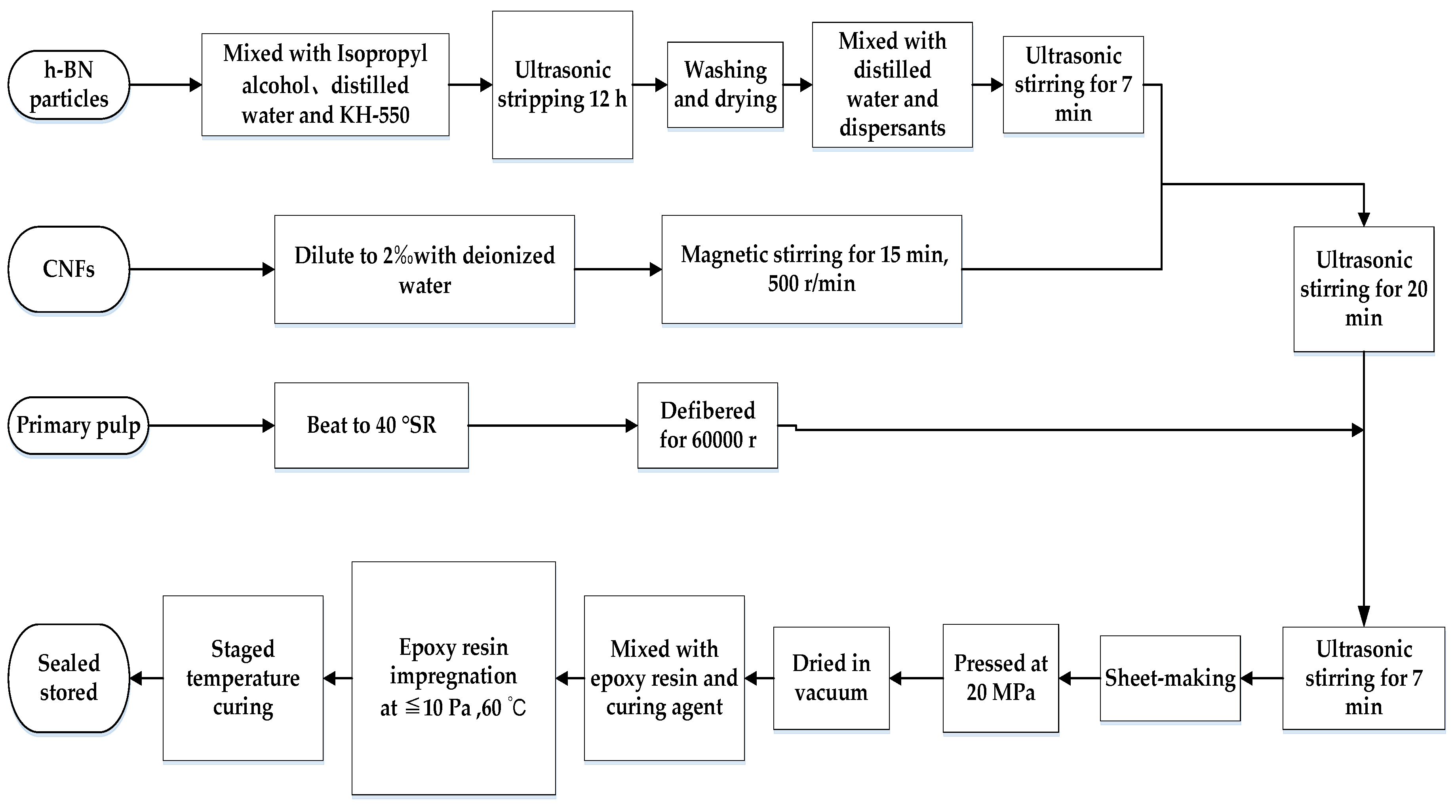
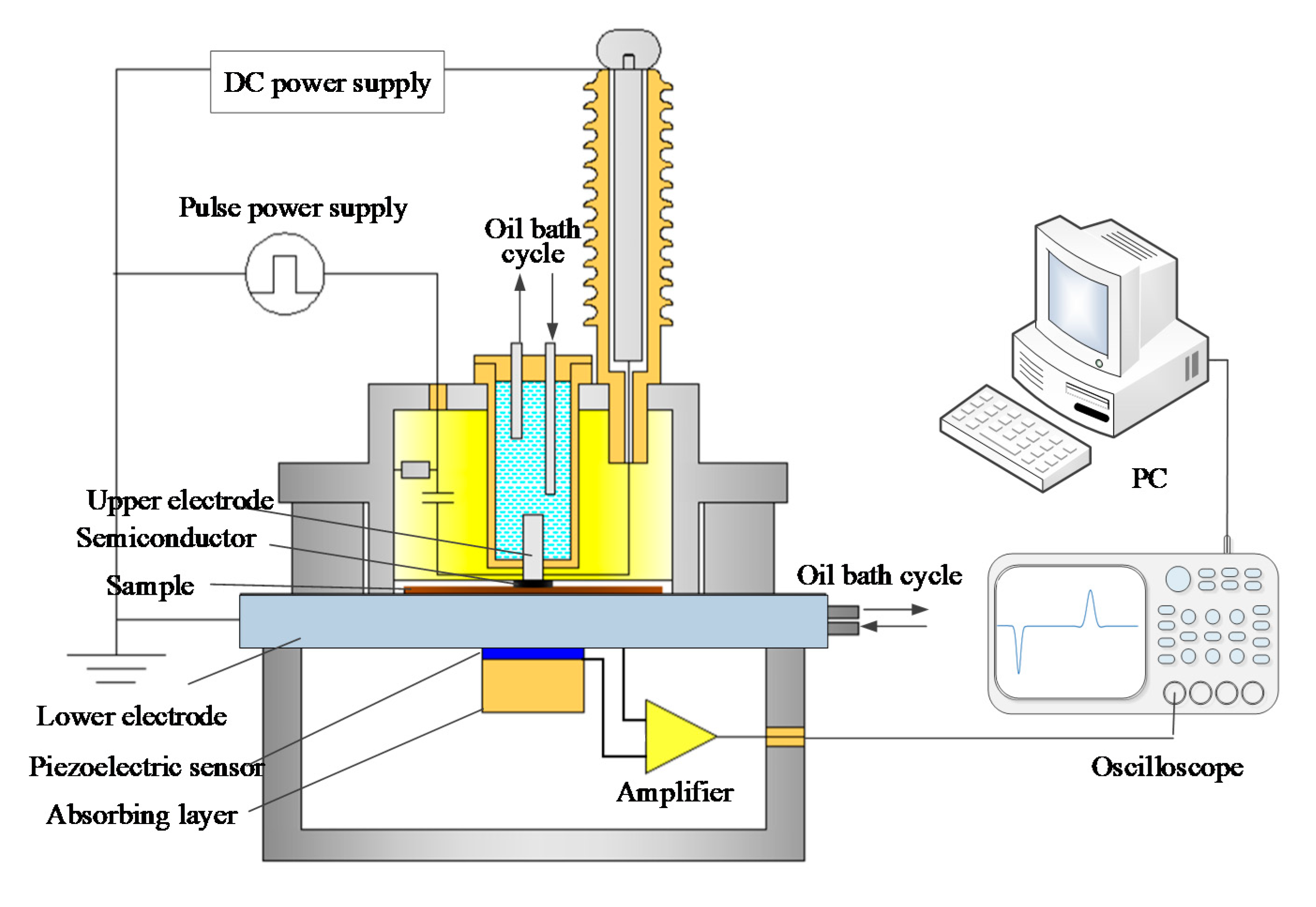
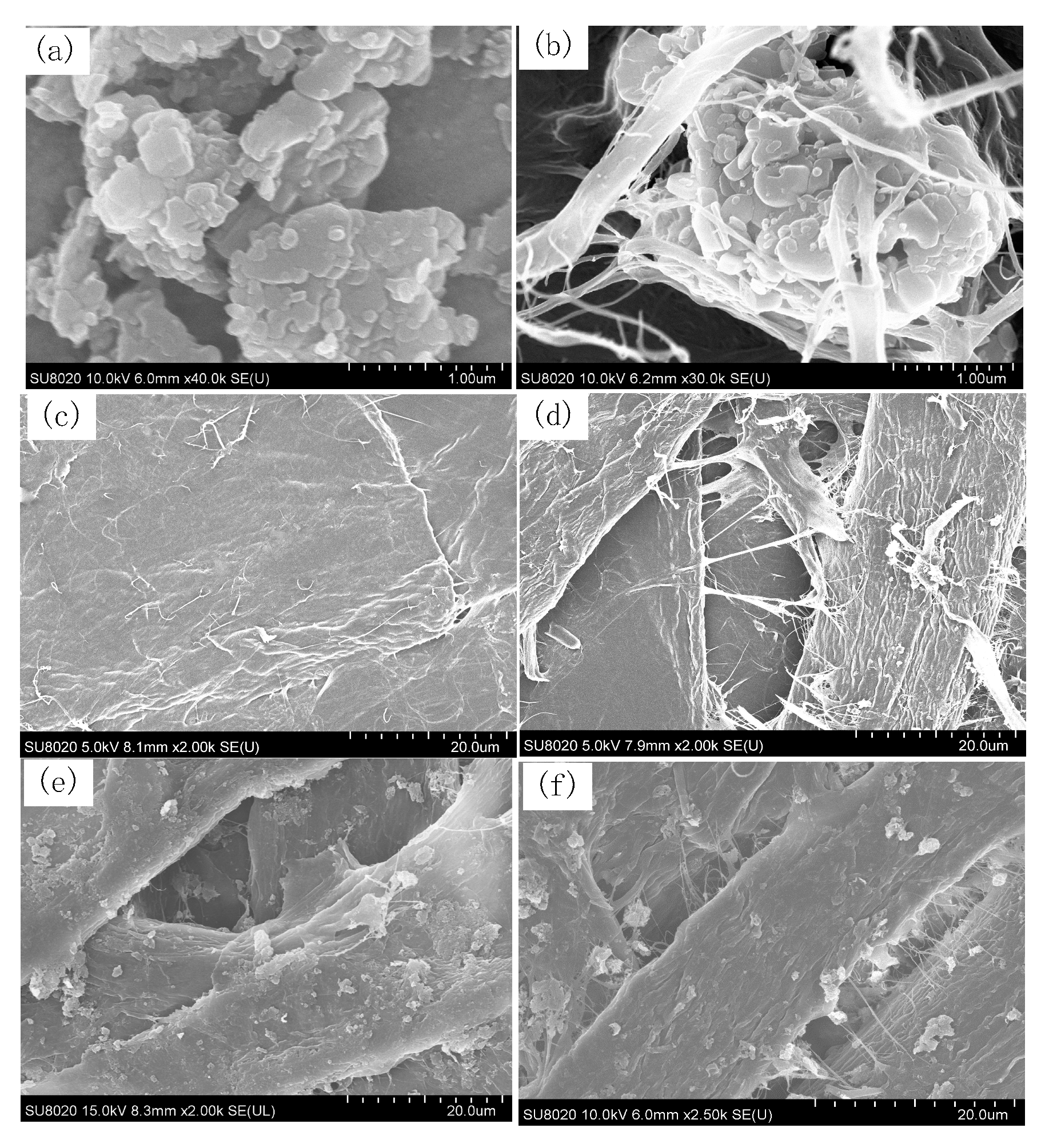


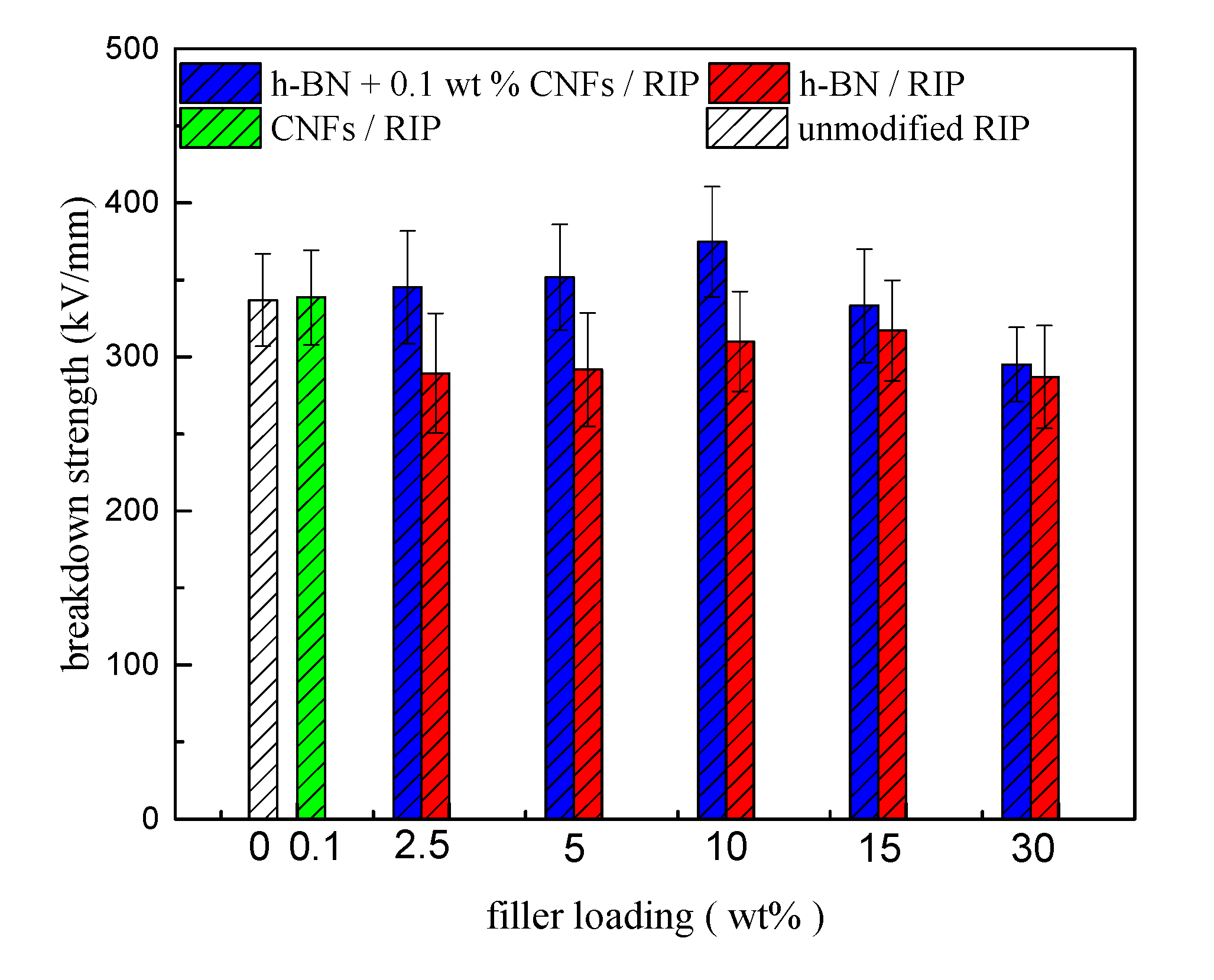

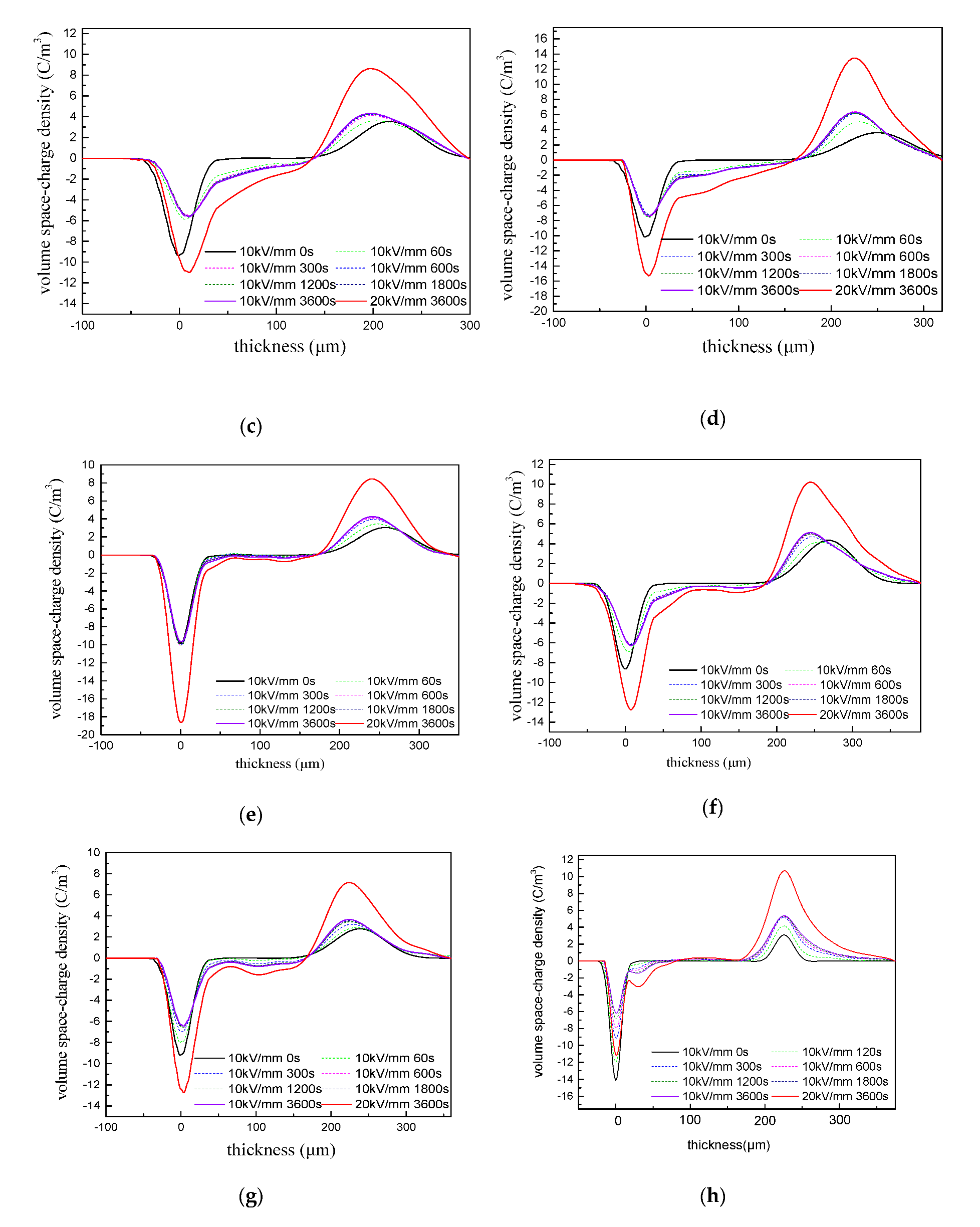
| Material or Equipment | Model or Parameter | Manufacturer |
|---|---|---|
| Distilled water | µ < 10 S/cm | Prepared in our laboratory |
| h-BN | Average diameter: 0.5 µm; thickness < 100 nm; purity > 99% | Peng Da Technology Co., Ltd. (Yingkou, China) |
| Nanocellulose fibers (CNFs) | Diameter: 3–50 nm; length: up to micron; purity > 99% | North Century Technology Research and Development Co., Ltd. (Beijing, China) |
| Epoxy resin | WSR618 (E-51) | Xingchen Synthetic Material Co., Ltd. (Nantong, China) |
| Curing agent | Methyl hexahydrophthalic anhydride (MHHPA) | Huicheng Electronic Materials Co., Ltd. (Puyang, China) |
| Accelerant | 2,4,6-Tri(dimethylaminomethyl)phenol (DMP-30) | Shanfeng Chemical Co., Ltd., (Changzhou, China) |
| Isopropyl alcohol | Analytical purity | Tianjin Fuyu Fine Chemical Co., Ltd. (Tianjin, China) |
| Coupling agent | KH-550 | Nanjing Union Silicon Chemical Co., Ltd. (Nanjing, China) |
| Beater | TD 6-23 | Tongda Light Power Equipment Co., Ltd., Xianyang, China |
| Ultrasonic cleaning machine | JP-020 | Jiemeng Cleaning Equipment Co., Ltd., (Shenzhen, China) |
| Standard agitator | DJ1C-100 | Dadi Automation Instrument, (Jintan, China) |
| Hand-sheet former | TD10-200 | Tongda Light Power Equipment Co., Ltd.,(Xianyang, China) |
| Curing press | XLB25-D | Shuangli Automation Technology Equipment Co., Ltd., (Huzhou, China) |
| Vacuum drying chamber | DZF-6210D | Haixiang Instrument and Equipment Factory, (Shanghai China) |
| Polyethylene glycol (PEG) | Degree of polymerization:2000 | Tianjin Guangfu Chemical Research Institute, (Tianjin, China) |
© 2020 by the authors. Licensee MDPI, Basel, Switzerland. This article is an open access article distributed under the terms and conditions of the Creative Commons Attribution (CC BY) license (http://creativecommons.org/licenses/by/4.0/).
Share and Cite
Yang, H.; Chen, Q.; Wang, X.; Chi, M.; Zhang, J. Dielectric and Thermal Conductivity Characteristics of Epoxy Resin-Impregnated H-BN/CNF-Modified Insulating Paper. Polymers 2020, 12, 2080. https://doi.org/10.3390/polym12092080
Yang H, Chen Q, Wang X, Chi M, Zhang J. Dielectric and Thermal Conductivity Characteristics of Epoxy Resin-Impregnated H-BN/CNF-Modified Insulating Paper. Polymers. 2020; 12(9):2080. https://doi.org/10.3390/polym12092080
Chicago/Turabian StyleYang, Hongda, Qingguo Chen, Xinyu Wang, Minghe Chi, and Jinfeng Zhang. 2020. "Dielectric and Thermal Conductivity Characteristics of Epoxy Resin-Impregnated H-BN/CNF-Modified Insulating Paper" Polymers 12, no. 9: 2080. https://doi.org/10.3390/polym12092080
APA StyleYang, H., Chen, Q., Wang, X., Chi, M., & Zhang, J. (2020). Dielectric and Thermal Conductivity Characteristics of Epoxy Resin-Impregnated H-BN/CNF-Modified Insulating Paper. Polymers, 12(9), 2080. https://doi.org/10.3390/polym12092080




